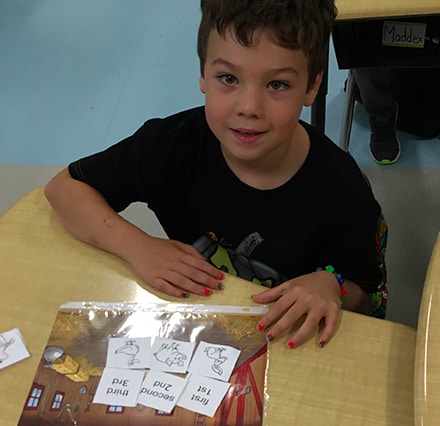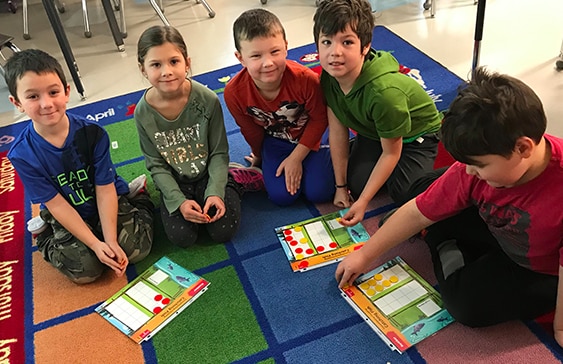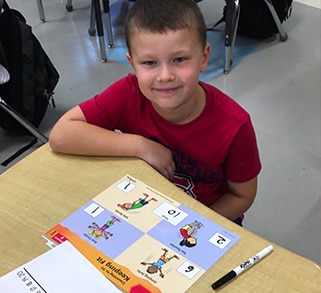K-12 Board Mathematics Facilitator | Sudbury Catholic Schools
How a District Changed the Math Story for Their Teachers and Grade 1 Students
Early in 2017, Sudbury Catholic Schools was searching for ways to “change the math story” for teachers and students in their elementary schools.
“We wanted to help teachers build their understanding of math content and pedagogical strategies while simultaneously making math more visual for younger students through representation and models,” explains Krista Sarmatiuk, K-12 Board Mathematics Facilitator.
That’s when they discovered Mathology. Sarmatiuk says when she and her colleagues saw how the program supported their math goals and reflects the work of well-known Math researchers they’d been following—such as Alex Lawson and Cathy Fosnot —they knew they’d found a tool worth trying.
Equipped with a Mathology Kit for each of the district’s 22 grade one classes along with K-3 Mathology Little Books for all 13 elementary schools, they introduced Mathology slowly over the 2017-2018 school year.

School-based facilitators trained and supported teachers in their classrooms—creating an atmosphere of support that Sarmatiuk says was key to busy teachers readily adopting a new program.
After just a few months of using Mathology, Sarmatiuk says the math story has started to change across the board.
Students have grown their math vocabulary, improved critical thinking skills and discovered the connections between math concepts.
And teachers continue to build their math content knowledge for teaching , thanks to embedded tools such as assessment prompts, guided next steps, lesson planning, and vocabulary guides.
“If you look at the grade one math curriculum expectations, they’re centred around verbs like ‘explore’ and ‘investigate.’ With Mathology they are encouraged to engage in and use those verbs. They are making sense of ideas by trying things out, by testing, by investigation.”
Krista Sarmatiuk
Improving math vocabulary
A key step in helping students feel more comfortable with math was helping them learn the language.
“Mathology is giving teachers the math language to use in a really concise way,” explains Sarmatiuk. Terms to introduce in the lesson are clearly outlined, and there are keywords on the front of activity cards and in the Little Books Teacher Guides.”
“Mathology is giving teachers the math language to use in a really concise way.”
Krista Sarmatiuk
“What’s happened is more teachers are using precise math language and putting it into context with the kids,” says Sarmatiuk. “Now, all of a sudden, we all have a better vocabulary. Teachers vocabulary choices strongly impact the child’s vocabulary choices. When they’re using more consistent language and understand it better, everyone’s math understanding increases.”

Providing opportunities for hands-on math learning
Sarmatiuk says one of her favourite aspects of Mathology is that the tools and activities aren’t paper and pencil based. Instead, they create opportunities for kids to do hands-on activities more frequently.
“Students have the opportunity to practice, think through lessons, talk with a buddy—literally explore math,” says Sarmatiuk.
“If you look at the grade one math curriculum expectations, they’re centred around verbs like ‘explore’ and ‘investigate.’ With Mathology they are encouraged to engage in and use those verbs. They are making sense of ideas by trying things out, by testing, by investigating.”
“The Mathology materials have content learning built into them. It’s been really helpful to have the instructional materials and the content learning wrapped into one unit when we’re trying to provide professional learning in the classroom.”
Krista Sarmatiuk
Nurturing critical thinking skills
All that hands-on learning is giving students plenty of opportunities to actually think about math. A helpful step when you consider that teachers in Sudbury Catholic Schools have identified that one of the biggest problems students face with math is they struggle with reasoning and thinking.
“Teachers feel that students either don’t understand the problem or they’re not thinking while they’re doing math,” explains Sarmatiuk.
Mathology helps teachers give them that opportunity.
“One of the things that we appreciated about the materials was their alignment to a lot of the various math researchers that are hard at work right now. The Mathology ideas and materials are really conducive to what it is we’re trying to help our teachers to learn about.”
Krista Sarmatiuk

“The Mathology program is structured to provoke students to do the thinking and then give the teacher an opportunity to interpret thinking with them,” explains Sarmatiuk.
Teachers are noticing students thinking their way through math problems, coming up with their own solutions and then clearly communicating the reasoning behind their approach.
“This gives really strong evidence of how students are able to reason and compare and determine relationships even from concepts they come up with on their own through experience,” says Sarmatiuk.
Supporting professional learning
Recognizing that math support isn’t always as plentiful as other subjects such as language arts, Sarmatiuk says part of the district’s reasons for choosing Mathology are based around providing professional learning opportunities for teachers.
“The Mathology materials have content learning built into them. It’s been really helpful to have the instructional materials and the content learning wrapped into one unit when we’re trying to provide professional learning in the classroom,” she explains.

Going forward
As a dual-track English and French immersion district, Sarmatiuk says the district has already started using the French version of Mathology in their immersion classes. In the past, they’ve been forced to use materials with language levels that are too advanced for the students’ current level. But that’s changed with Mathology.
“Our kindergarten teachers are telling us they really appreciate the level of language—especially in the Little Book stories—they say the language being used is very appropriate,” says Sarmatiuk.
Going forward, Sarmatiuk says Sudbury Catholic Schools will implement Mathology’s grade two English materials in September 2018 for all 13 of the district’s elementary schools. She’s looking forward to seeing how the skills students are gaining translate into learning in grades three, four, five and beyond.


